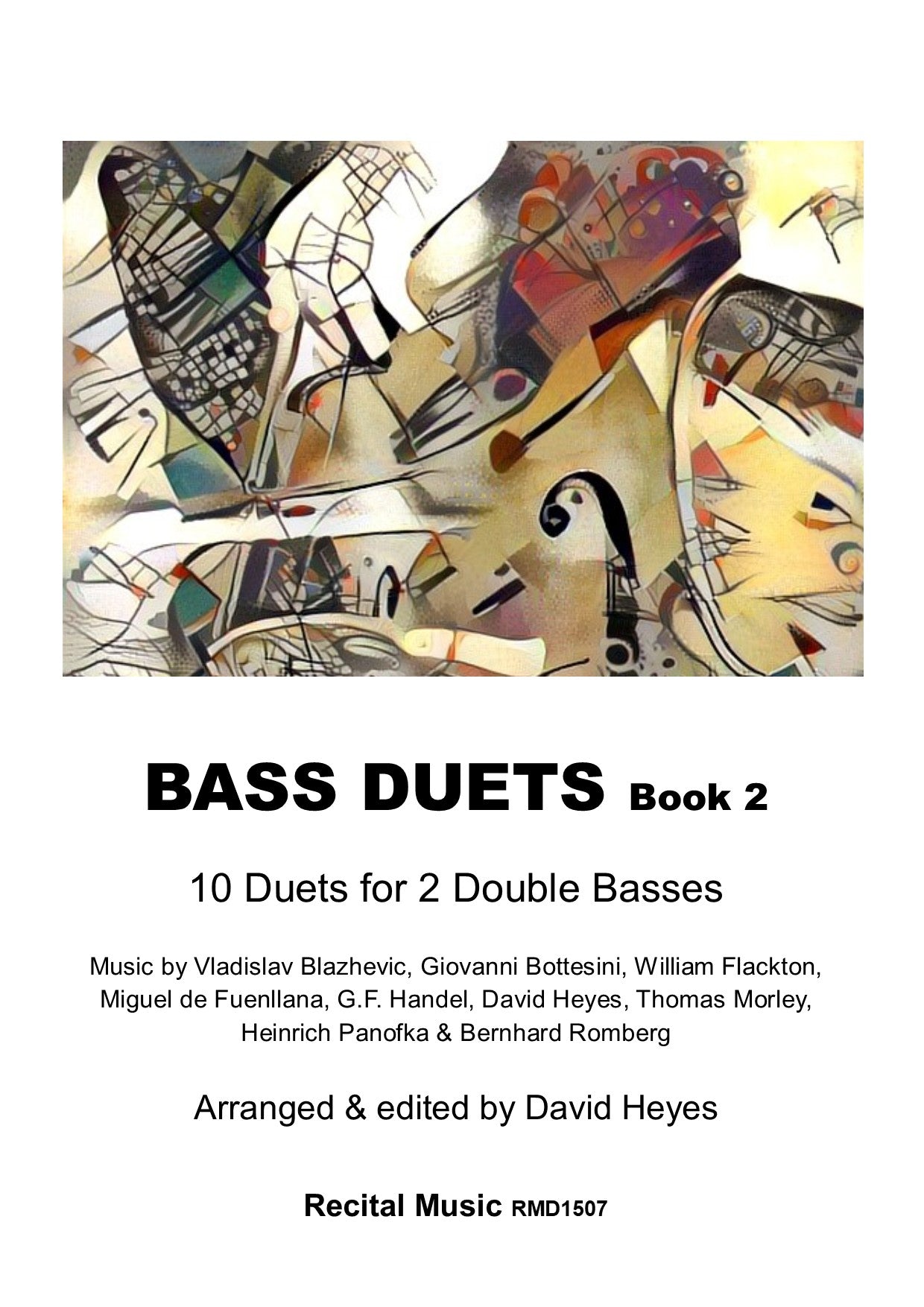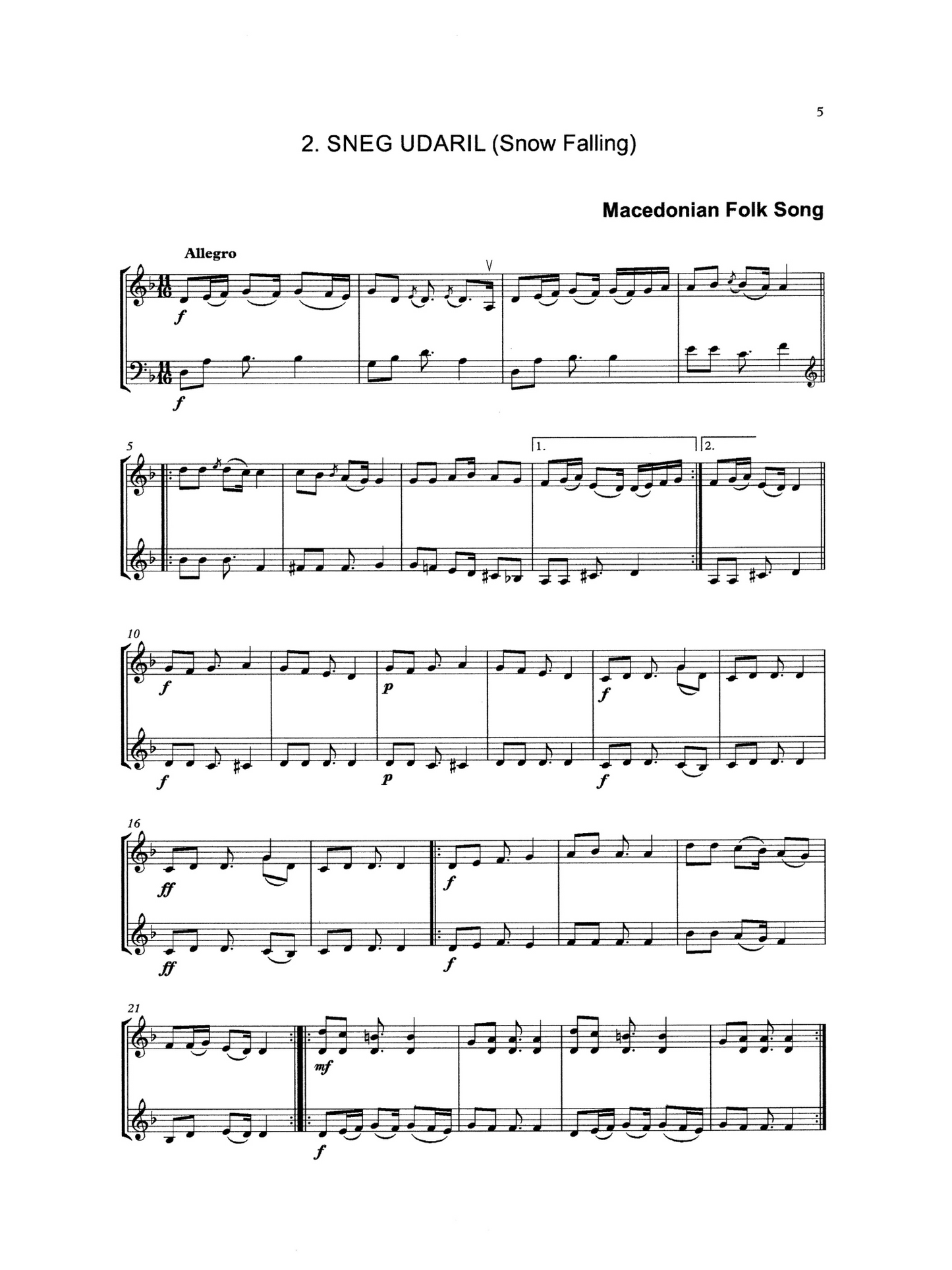David Heyes
Bass Duets Book 2: 10 Duets for 2 double basses (ed. Heyes)
Bass Duets Book 2: 10 Duets for 2 double basses (ed. Heyes)
Couldn't load pickup availability
About the Duets
Bass Duets Book 2 features ten inventive and accessible concert duets for the intermediate-advanced duo - two original works and eight transcriptions. A wealth of styles and idioms include duets from the 16th-century to the present day, encompassing music which is both player and audience friendly, exploring the entire range of the double bass.
Ideal as concert repertoire, sight-reading practice, or just to play with a friend. Edited and arranged by David Heyes
Table of Contents
1. David Heyes (b.1960) - Serenity - a Meditation for Sara
2. Macedonian Folk Song - Sneg Udaril (Snow Falling)
3. Bernhard Romberg (1767-1841) - Allegro - Sonata in E flat major Op.43, No.1
4. Giovanni Bottesini (1821-1889) - Andante (Gran Duetto No.2)
5. G.F. Handel (1685-1759) - Andante (Sonata No.VIII in G minor)
6. Thomas Morley (1557-1602) - Fantasie La Girandola
7. William Flackton (1709-1798) - Solo in G major
8. Miguel de Fuenllana (1500-1579) - Duo (Orphénica Lyra)
9. Vladislav Blazhevich (1881-1942) - Concert Duet No.15
10. Heinrich Panofka (1807-1887) - Melodic Study No.1
About the Composers
1) David Heyes is an English double bassist and composer. He founded Recital in 1986, now in its 38th year, and has commissioned more than 750 works for the double bass over the past forty years. Serenity - a Meditation for Sara was composed in 2016, exists in versions for double bass trio and quartet, and was rearranged for double bass duet in 2024. The music emphasises the lyrical and sonorous qualities of the double bass throughout its rich and melodic middle register.
2) Sneg Udaril was originally composed for three voices and arranged for double bass trio by David Heyes, who subsequently transcribed it for duet. Its 11/16-time signature and rhythmic energy make this a firm favourite with players and audiences alike. The piece is fun, dramatic and exciting alongside effective musical and technical challenges.
3) Bernhard Romberg was a German cellist and composer who wrote a significant number of works for the cello. Op.43 is a set of three sonatas for two cellos, also playable with double bass accompaniment, and Sonata No.1 was originally in the key of B flat major and was first published in 1825. In three contrasting movements,
the opening Allegro is bright and characterful, utilising the middle register of the double bass, with a confident and supportive accompaniment which adds depth and rhythmic security.
4) Giovanni Bottesini was the greatest double bass soloist of the 19th-century and his music is still at the heart of the double bass repertoire today. Tre Gran Duetti for double bass duet date from the late 1830s, during Bottesini’s studies at Milan Conservatoire, and are dedicated to his double bass professor Luigi Rossi. Gran Duetto No.2 has three contrasting movements and Bottesini exploits the lyrical and virtuosic possibilities of the double bass in music which is vibrant and engaging. The melodic material is shared between the two players, with opportunities to display more than simply technical accomplishment, and demonstrate Bottesini’s amazing talents as a fully-formed composer and soloist from his earliest studies.
5) G.F. Handel was one of the greatest composers of the Baroque age. He was born in Germany, worked in Italy and lived in London for much of his life. Sonata No.8 dates from c.1719 and was originally for 2 violins or oboes and continuo, and the opening Andante has grandeur and nobility, with melodic interest for both players, and this edition incorporates some of the continuo part between the two players.
6) Thomas Morley was one of the foremost member of the English Madrigal School and was active in church music as a singer, composer and organist. Fantasie La Girandola is from his First Book of Canzonets to Two Voyces, dating from 1595, and the collection of 21 pieces includes 12 canzonets for 2 voices and nine fantasias for 2 instruments. The combination of two-part counterpoint and suspensions create music of great beauty and clarity. It can be played with or without vibrato and the melodic lines and musical direction should indicate the dynamic range to employ.
7) William Flackton was an English bookseller, publisher, organist, violist and composer. He is known today for his works for the viola and in 1770 he published Six Solos, three for cello and three for viola, with cello or harpsichord accompaniment. Sonata No.1 is in C major, originally for cello and continuo, and the central Allegro Moderato has been transposed into G major for this edition. The music is elegant and stylish, with a simple and supportive accompaniment, demonstrating a confident and assured composer with a love for the viola and cello.
8) Miguel de Fuenllana was a Spanish composer and is believed to have been blind from birth. Orphénica Lyra (1554) features 182 pieces in six volumes, including motets for voices alongside 51 fantasias by Fuenllana and 17 by other composers. The Duo was originally written for vihuela de mano, a 15th-century fretted plucked string instrument, shaped like a guitar but tuned like a lute, and transcribes beautifully for double bass duet.
9) Vladislav Blazevich was a Russian trombonist, teacher and composer. He was professor of trombone at the Moscow Conservatoire, principal trombone of the Bolshoi Theatre Orchestra, and is widely known for his compositions for trombone and tuba. He was a founder member of the Soviet trombone and tuba school and composed a wealth of music for both instruments. His 38 Concert Duets for two trombones were first published in the early 1940s and offer musical and technical
challenges in equal measure. Concert Duet No.15 is a fun and exciting duet, with constantly changing time signatures, and a vibrant rhythmic momentum from beginning to end.
10) Heinrich Panofka was a German violinist, voice teacher and composer and is remembered today primarily for his vocal studies. He lived and worked in Paris, London and Florence, encompassing a successful and interesting career as a performer, teacher, writer and composer. Panofka’s 24 Etudes (Op.30), first published in 1841, include progressive violin studies, accompanied by a second violin, and Duet No.1 is lyrical and evocative, with a simple and supportive arpeggio-like accompaniment.











